
 |
Tea Clipper |
 |
| from TeaAntiques.com | ||
| Edition Twenty Five |
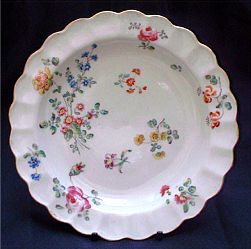 My Featured Antique for November, is a rare and delightful
scolloped edged Worcester plate. Charmingly decorated by the famous James Giles,
with delicate sprays and sprigs of coloured enamel hand painted flowers. This
beautiful plate, although bearing no manufacturer's marks, was manufactured by
the Worcester factory and then decorated by James Giles in his London studio.
The plate exhibits flowers typical of and associated with James Giles - such as
the orange lily flower.
My Featured Antique for November, is a rare and delightful
scolloped edged Worcester plate. Charmingly decorated by the famous James Giles,
with delicate sprays and sprigs of coloured enamel hand painted flowers. This
beautiful plate, although bearing no manufacturer's marks, was manufactured by
the Worcester factory and then decorated by James Giles in his London studio.
The plate exhibits flowers typical of and associated with James Giles - such as
the orange lily flower.
The plate has charming flowers dotted around the entire surface of the plate, very much in the popular "Meissen" style that was very much in fashion in England during the middle part of the eighteenth century. These colourful flowers have been exquisitely executed by hand in very rich colours producing extremely decorative results. The edge of the plate is moulded with radiating panels, which lead to a scolloped edge to which has been applied gilding to the rim.
More details of this item and other tea related antiques can be found by visiting my web site at www.TeaAntiques.com.
My travels this month take me to Bristol, an important eighteenth century town, not quite on the uniformed and grand architectural design as nearby Bath, but a remarkable city in its own right. Bristol grew in the eighteenth century as an important port. It was from here that there were many rich traders were based, with dealings in the West-Indies and America.
Like Bath, Bristol grew with new Georgian terraces, squares and crescents being built. The designers engaged on these projects at the time were the Paty family. Thomas (1718-1789) together with his two sons John and William were certainly regarded as the most important designers towards the end of the eighteenth century in Bristol. Their designs of uniform streets of houses from the 1760’s include College Green, the lower part of Park Street. Later house terraces from the 1780’s include the Upper part of Park Street, Great George Street and Berkley Square.
One 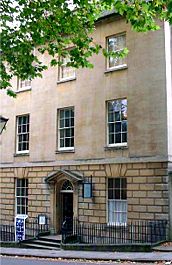
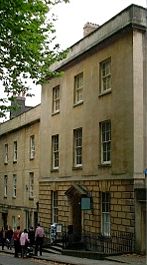 such house is now ‘The Georgian House’ at No 7 Great George Street. The
house title says all, it is now a museum devoted to eighteenth century life
style.
such house is now ‘The Georgian House’ at No 7 Great George Street. The
house title says all, it is now a museum devoted to eighteenth century life
style.
The exterior of the house in Bath honey coloured stone looks somewhat plain. However, it does convey the simple but elegant proportions of eighteenth century design. The front elevation of the house is typical of Georgian symmetry. The ground floor has a central door way with a sash window on either side. This ground floor of the house is given a solid appearance by giving it a stone block design. This gives a base above which are two further principle floors three bays wide.
The house was actually built for John Pinney between 1788 and 1791. John was then a wealthy sugar merchant. He had been involved and lived for some time, in the West Indies Island of Nevis, where the Pinney family had developed their Sugar plantations. In 1772 he married Jane, only daughter of William Burt Weekes of Nevis. It was in 1783 they returned to England to settle in Bristol.
He later founded the firm of sugar merchants-'Pinney and Tobin’. This was a successful venture, bringing him in five times the wealth already attained from his West Indies sugar plantations. He still kept a close interest in the West Indies plantations and the care of his Negro slaves.
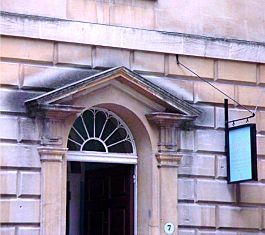 Entering this delightful town house through the front door, its pedimented
door case and simple fan light, leads the visitor into the Hall. To the left is
the Library (or study), furnished, like the rest of the house, in contemporary
late Georgian style.
Entering this delightful town house through the front door, its pedimented
door case and simple fan light, leads the visitor into the Hall. To the left is
the Library (or study), furnished, like the rest of the house, in contemporary
late Georgian style.
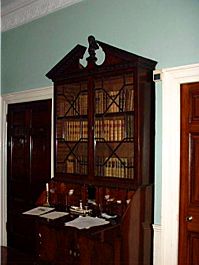
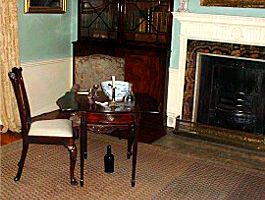
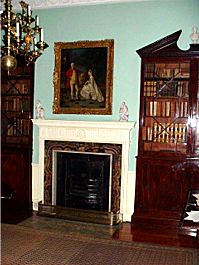
In the study there are some original pieces of furniture to the house, they are the two built-in book cases and the magnificent mahogany bureau-bookcase dating from c1750. This bureau has a pair of cupboard doors rather than long drawers below the desk, which is rather unusual. Portraits of John Pinney and his youngest son of seven children, hang in this room. The room is set with a beautiful mahogany Pembroke table, on which are some fine eighteenth century drinking glasses. Under the table is a Georgian glass wine bottle. .
The walls of this room are painted in a pale ‘Wedgewood’ blue with white below the dado rail which runs round the room at the height of the chair backs.
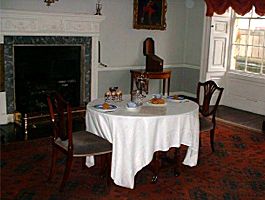 Passing on through to the rooms at the back of the house on this floor, the
visitor enters the Breakfast Parlour and the Eating Room. These two rooms almost
appear as one, connected by a very large open arch, this apparently is an
original feature.
Passing on through to the rooms at the back of the house on this floor, the
visitor enters the Breakfast Parlour and the Eating Room. These two rooms almost
appear as one, connected by a very large open arch, this apparently is an
original feature.
These two eating rooms are simply Georgian elegance at its best. The walls of the Breakfast Parlour and Eating Room are painted in two tone grey. The bare floorboards covered with patterned carpet rugs.
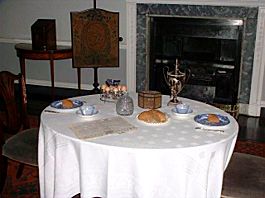 Starting with the Breakfast Parlour, the room has been carefully laid out
with a gate-leg table, covered with a white damask cloth, set for a Georgian
breakfast. This is a sheer delight to see and has some wonderful items to enjoy.
The first thing to catch my eye was the pretty little tea urn, elegant in its
vase shape, standing on four small ball feet and having an Ivory tap. This would
provide the hot water for the breakfast tea. Alongside the Tea Urn is a
hexagonal Tea Caddy, with scroll paper work design. This design was achieved
using tightly rolled paper, which was then cut into thin cross sections and
applied to the surfaces of the caddy.
Starting with the Breakfast Parlour, the room has been carefully laid out
with a gate-leg table, covered with a white damask cloth, set for a Georgian
breakfast. This is a sheer delight to see and has some wonderful items to enjoy.
The first thing to catch my eye was the pretty little tea urn, elegant in its
vase shape, standing on four small ball feet and having an Ivory tap. This would
provide the hot water for the breakfast tea. Alongside the Tea Urn is a
hexagonal Tea Caddy, with scroll paper work design. This design was achieved
using tightly rolled paper, which was then cut into thin cross sections and
applied to the surfaces of the caddy.
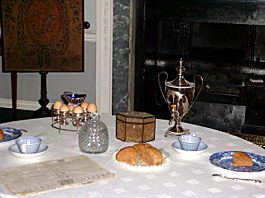 The result is a wonderful textured
appearance. A heavy cut glass honey pot, exquisitely shaped in the form of a
circular beehive sits sparkling in the light. A silver egg frame or cruet sits
in the centre of the table. In this would have been served the boiled eggs, the
blue glass lined dish at the top housing the salt. These egg frames look so
elegant and must have been a delightful way to serve the breakfast eggs. Places
are set and a newspaper ready on the table to catch up on the
essential news of the day.
The result is a wonderful textured
appearance. A heavy cut glass honey pot, exquisitely shaped in the form of a
circular beehive sits sparkling in the light. A silver egg frame or cruet sits
in the centre of the table. In this would have been served the boiled eggs, the
blue glass lined dish at the top housing the salt. These egg frames look so
elegant and must have been a delightful way to serve the breakfast eggs. Places
are set and a newspaper ready on the table to catch up on the
essential news of the day.
On either side of the fireplace stand two pretty demi-lune tables, on which are two Cutlery boxes, used to hold the valuable silver cutlery.
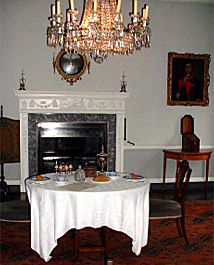
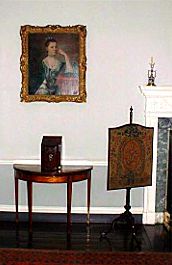
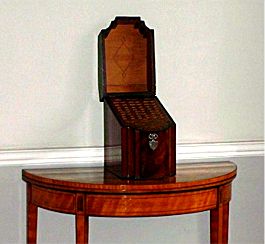
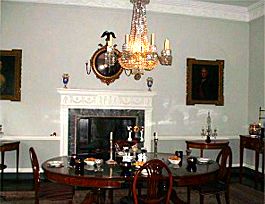
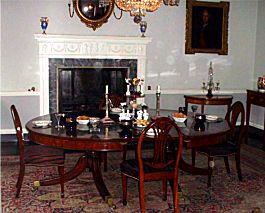 On the other side of the connecting arch, the Eating
Room is set out with a
dining table and chairs. The table is oval and stands on two tripod supports,
the legs terminating in brass casters. The dining chairs, with their charmingly
carved back splats, have unusually pointed backs. The table is set with some
fine Georgian glass and china, including the pretty glass central tazza,
decorated with jelly glasses and flowers, below which are some small china
figures used to decorate the table. There are some Bristol manufactured
eighteenth century plates, each hand painted with flower sprigs and having
moulded scalloped rims.
On the other side of the connecting arch, the Eating
Room is set out with a
dining table and chairs. The table is oval and stands on two tripod supports,
the legs terminating in brass casters. The dining chairs, with their charmingly
carved back splats, have unusually pointed backs. The table is set with some
fine Georgian glass and china, including the pretty glass central tazza,
decorated with jelly glasses and flowers, below which are some small china
figures used to decorate the table. There are some Bristol manufactured
eighteenth century plates, each hand painted with flower sprigs and having
moulded scalloped rims.
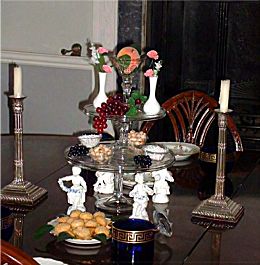
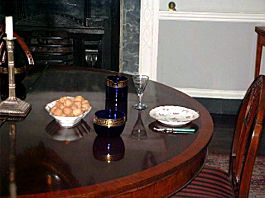
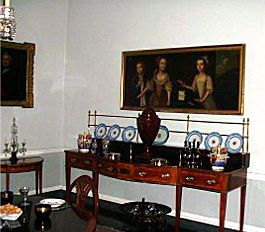 At one end of the room is a large mahogany sideboard. On this is displayed
some more china, silver and glass. The most striking thing on this sideboard is
a gorgeous vase shaped cutlery box, like those in the Breakfast Parlour,
designed to store the family's valuable silver cutlery.y.
At one end of the room is a large mahogany sideboard. On this is displayed
some more china, silver and glass. The most striking thing on this sideboard is
a gorgeous vase shaped cutlery box, like those in the Breakfast Parlour,
designed to store the family's valuable silver cutlery.y.
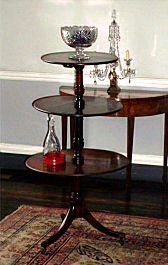
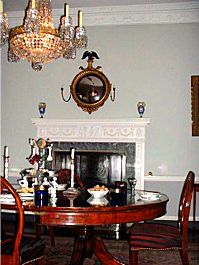 Standing at the other end of the dining table is a mahogany dumb waiter, with a central column on three legs. This piece of furniture was
designed to hold items of food and drink that the guests could help themselves
too, in a more intimate environment - the butler and staff having been dismissed
at the end of the meal.
Standing at the other end of the dining table is a mahogany dumb waiter, with a central column on three legs. This piece of furniture was
designed to hold items of food and drink that the guests could help themselves
too, in a more intimate environment - the butler and staff having been dismissed
at the end of the meal.
A Regency style mirror hangs above the white fireplace, and has an eagle at its pediment and two candle arms either side of the circular convex mirror to maximise the light that they would emit during evening dinners. This mirror also reflects the light that would be given off from the central Regency crystal glass chandelier. This is a charming room, in which it is easy to imagine eighteenth century dinners enjoying their evening dinner.
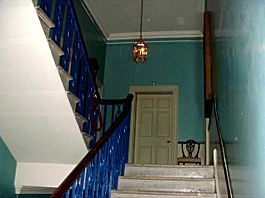 Leaving the Eating Room and going back into the hall and up a flight of the
elegant cantilever stairs the visitor enters the Drawing Room. As in most
eighteenth century town houses the Drawing Room, which was the principle room
for entertaining guests, was positioned on the first floor and was often the
grandest room in the house. This Drawing Room is no exception, positioned above
the two eating rooms, it is of large proportions. It is furnished as it would
have been in the late eighteenth century, with the sparse furniture arranged
around the room up against the walls. This formal arrangement only broken as the
room was used for entertaining and maybe the playing of card games etc.
The Drawing Room has three sash windows along one side, the view from which
in the eighteenth century would have been out across the port. Sadly, this view
has since been lost by later developments behind the house.
Leaving the Eating Room and going back into the hall and up a flight of the
elegant cantilever stairs the visitor enters the Drawing Room. As in most
eighteenth century town houses the Drawing Room, which was the principle room
for entertaining guests, was positioned on the first floor and was often the
grandest room in the house. This Drawing Room is no exception, positioned above
the two eating rooms, it is of large proportions. It is furnished as it would
have been in the late eighteenth century, with the sparse furniture arranged
around the room up against the walls. This formal arrangement only broken as the
room was used for entertaining and maybe the playing of card games etc.
The Drawing Room has three sash windows along one side, the view from which
in the eighteenth century would have been out across the port. Sadly, this view
has since been lost by later developments behind the house.
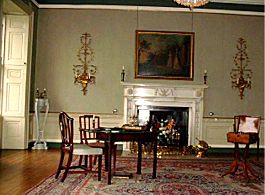
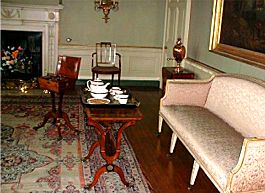
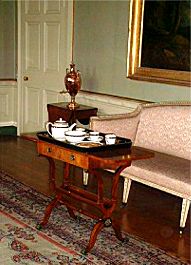 Furniture in the Drawing
Room includes a set of pretty gilt framed open arm
chairs and large Adam style settee. These all date from c1780. In front of the
settee on a small sofa table is a black papier mâché tray containing a Derby tea
set, c1790. this teaset is of the new fluted design with blue and gilt borders.
Another essential tea antique is the tea poy that stands to one side of the
sofa table. This is a charming tea poy, Regency in date, having a rectangular
top section which is geometrically inlaid with black ebony. Instead of being on
a single column, this one is supported on two shaped and turned supports down to
the base section. From there the whole stands on four sabre legs capped in small
brass casters. A delightful piece of furniture that would contain the precious
tea, essential for the tea ceremony!
Furniture in the Drawing
Room includes a set of pretty gilt framed open arm
chairs and large Adam style settee. These all date from c1780. In front of the
settee on a small sofa table is a black papier mâché tray containing a Derby tea
set, c1790. this teaset is of the new fluted design with blue and gilt borders.
Another essential tea antique is the tea poy that stands to one side of the
sofa table. This is a charming tea poy, Regency in date, having a rectangular
top section which is geometrically inlaid with black ebony. Instead of being on
a single column, this one is supported on two shaped and turned supports down to
the base section. From there the whole stands on four sabre legs capped in small
brass casters. A delightful piece of furniture that would contain the precious
tea, essential for the tea ceremony!
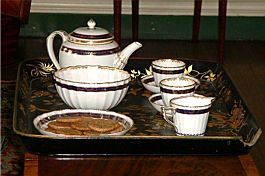
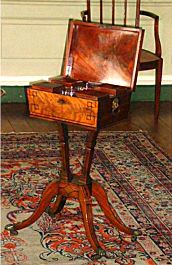
A Copper Tea Urn sits on an oval Urn table to the side of the Settee, completing the necessary tea equipage.
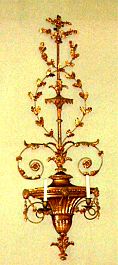 Worth noting too in this delightful and spacious room are a fine pair of
gilded wall lights, called girandoles. They are so very delicate in their design
and suit the room admirably. .
Worth noting too in this delightful and spacious room are a fine pair of
gilded wall lights, called girandoles. They are so very delicate in their design
and suit the room admirably. .
There are some fine large oil paintings hung on the walls of the drawing room, one to note is the ‘view of Nevis from St Kitts’ by Nicholas Pocock. This was commissioned by John Pinney in 1790 and cost him 45 guineas, obviously an important reminder of the Island containing his sugar plantations.
Also on this floor, opposite the Drawing room, are two rooms that would have originally been a bedroom and small Drawing Room. These are now set out as a Ladies' Drawing room and a Library.
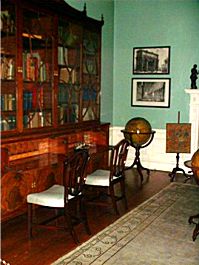
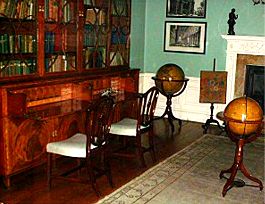 In
the Library stands a mighty fine and imposing double Secretaire bookcase
c1800. The astragals or glazing bars in this bookcase are beautifully designed
with sweeping curves and loops with a central vase shape to them. The quality of
this stunning piece of furniture is second to none. The grain and colour of the
Cuban mahogany is superb, the top mounted with small urn finials. Two globes on
stands are positioned in the Library and would have been very useful in relating
to world affairs.
In
the Library stands a mighty fine and imposing double Secretaire bookcase
c1800. The astragals or glazing bars in this bookcase are beautifully designed
with sweeping curves and loops with a central vase shape to them. The quality of
this stunning piece of furniture is second to none. The grain and colour of the
Cuban mahogany is superb, the top mounted with small urn finials. Two globes on
stands are positioned in the Library and would have been very useful in relating
to world affairs.
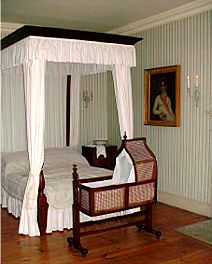
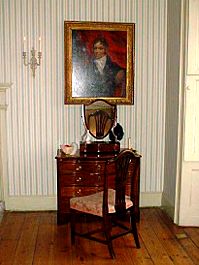 Climbing
another flight of the main stairs leads the visitor to what would have been a
floor containing five rooms, then used as bedrooms and dressing rooms. One of
these rooms is now displayed as a principle bedroom containing a four-poster bed
in the style of Hepplewhite. This room is simply furnished and very light in its
appearance. At the foot of the bed is a swinging child’s cradle, hung like the
bed with white hangings.
Climbing
another flight of the main stairs leads the visitor to what would have been a
floor containing five rooms, then used as bedrooms and dressing rooms. One of
these rooms is now displayed as a principle bedroom containing a four-poster bed
in the style of Hepplewhite. This room is simply furnished and very light in its
appearance. At the foot of the bed is a swinging child’s cradle, hung like the
bed with white hangings.
Making tracks back down the stairs to the hall and then on down a separate set of narrow stairs into the kitchen and service area, the visitor can now see what life was like for the eighteenth century servant. The kitchen of this house is not the worst that I have encountered - it is quite light and airy. There is the large black leaded cooking range on one side together with the bread ovens to the left of it and on the other side of the kitchen, a dresser containing the copperware needed to produce the decorative dishes for the dinners etc. Note that there is a sugar cone sat on the central kitchen table. It is to such sugar that John Pinney had to thank for his wealthy lifestyle.
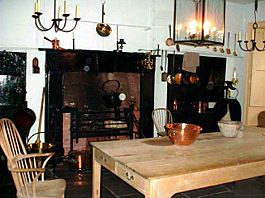
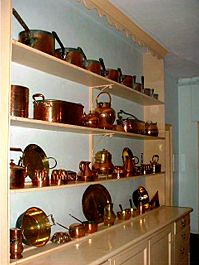
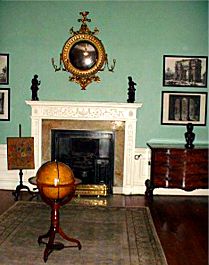 The Georgian House is indeed a treasure trove of Georgian furnishings and a
wonderful insight into the life style of a wealthy merchant, at the end of the
eighteenth century. A museum that I would strongly recommend visiting to anybody
who loves and appreciates this period in English history. It is lovely to see
each room set, such that one can easily imagine life of its Georgian
inhabitants, almost as if they were about to appear right in front of you at any
moment! !
The Georgian House is indeed a treasure trove of Georgian furnishings and a
wonderful insight into the life style of a wealthy merchant, at the end of the
eighteenth century. A museum that I would strongly recommend visiting to anybody
who loves and appreciates this period in English history. It is lovely to see
each room set, such that one can easily imagine life of its Georgian
inhabitants, almost as if they were about to appear right in front of you at any
moment! !
In the late eighteenth century blue coloured glass was first introduced, and it was at Bristol, together with other places such as London, the Midlands and Newcastle, that this beautiful deep blue glass was produced. Glass making at Bristol, like other glass manufacturing areas of the period, were located at places where there was an availability of coal to fire their glass furnaces, and where their glass products could be easily and cheaply transported. As a port, Bristol was an ideal location for the glass industry to develop. Finished glass wares could easily be transported by sea, a very cheap method of transport compared to by road.
The glass industry had been operating in Bristol from around the 1690s and in the eighteenth century, it was known to have fifteen glass houses in production. However, by the 1830s (towards the end of the Georgian period), glass making had nearly all shifted to Newcastle and Stourbridge. With these now the main production areas, Bristol was reduced to four glass houses. Today there are no glass manufacturers in Bristol.
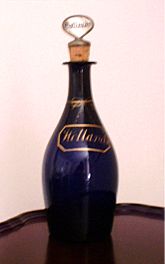 Collectors and dealers today, nearly always refer to any item of blue
coloured glass as 'Bristol' blue, but as already mentioned this blue (and other
coloured glass ware) were produced in places outside of Bristol. The link with
Bristol seems to have stuck though. It is very difficult with glass to attribute
it to specific areas or manufacturers, most glass being unmarked and therefore
anonymous.
Collectors and dealers today, nearly always refer to any item of blue
coloured glass as 'Bristol' blue, but as already mentioned this blue (and other
coloured glass ware) were produced in places outside of Bristol. The link with
Bristol seems to have stuck though. It is very difficult with glass to attribute
it to specific areas or manufacturers, most glass being unmarked and therefore
anonymous.
Certainly, by the early 1800s, coloured glass, particularly blue glass had become very popular and fashionable for domestic table glass. The blue glass could be beautifully decorated with bright gilding, the dark blue of the glass being a perfect backdrop to the honey colour of the gilding.
I would like to link some glass decoration to James Giles of London. He was perhaps better remembered for his work in the exquisite decoration of fine Worcester porcelain, (such as the James Giles plate which I have shown above as my antique of the month). However, he also did some remarkable gilding work in the fine decorating of glass wares. Like his decorating on porcelain, he did some remarkable glass gilding using design which included flowers, insects - much in the style of his porcelain decorations. He is know to have decorated such items as decanters, scent bottles and vases.
There were many domestic glass products produced, including wine glasses, Tea caddy mixing bowls, finger bowls, decanters, cruet bottles and wine glass coolers - but to name just a few!
 As
you might expect, there are some items of 'Bristol' blue glass on display in the
Georgian House, in Bristol. In the dining room on the dining table, can be seen
some very attractive finger bowls and double lipped wine glass coolers. These
are wonderfully embellished with 'Greek key' style gilding.
As
you might expect, there are some items of 'Bristol' blue glass on display in the
Georgian House, in Bristol. In the dining room on the dining table, can be seen
some very attractive finger bowls and double lipped wine glass coolers. These
are wonderfully embellished with 'Greek key' style gilding.
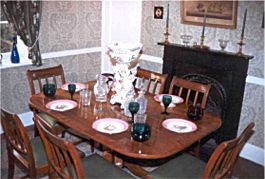 In the
Charles Dickens's birthplace museum in Portsmouth, there are some Bristol blue
decanters on the windowsill of the dining room, together with some coloured
wine glasses and finger bowls upon the dining table.
In the
Charles Dickens's birthplace museum in Portsmouth, there are some Bristol blue
decanters on the windowsill of the dining room, together with some coloured
wine glasses and finger bowls upon the dining table.
Currently, on my own TeaAntiques website, I have a pair of 'Bristol' blue 'Hollands' (gin) and 'Brandy' spirit decanters on offer (They have been sold since this article was written). These delightful decanters are gorgeously gilded with bottle labels, complete with their gilt chains which are elegantly tied to the neck ring with a fashioned gilt bow. Such 'Bristol' blue spirit decanters usually have a capacity of exactly 1 pint.
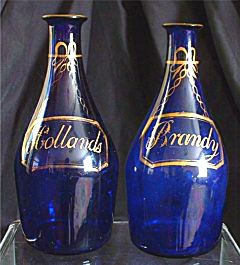
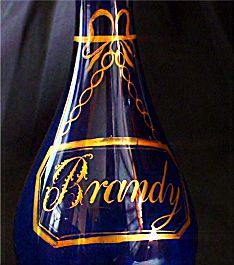
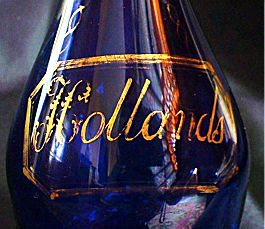
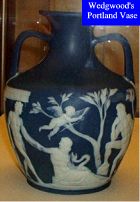 Although
this style of blue glass became in vogue during this period in history, we must
not forget that in fact coloured glass had been introduced much earlier. The
ancient Egyptians were known to have produced coloured glass wares. The
'Portland Vase', (now in the British Museum, London), is indeed a blue glass
vase with a white glass overlay, this dating from the 1st century A.D. But it is
in the Georgian period that I feel this blue and coloured glass manufacturing
saw its golden years. Coloured domestic glass, particularly 'Bristol' blue
from the late eighteenth and early nineteenth centuries can inspire the
collector of antique Georgian glass wares.
Although
this style of blue glass became in vogue during this period in history, we must
not forget that in fact coloured glass had been introduced much earlier. The
ancient Egyptians were known to have produced coloured glass wares. The
'Portland Vase', (now in the British Museum, London), is indeed a blue glass
vase with a white glass overlay, this dating from the 1st century A.D. But it is
in the Georgian period that I feel this blue and coloured glass manufacturing
saw its golden years. Coloured domestic glass, particularly 'Bristol' blue
from the late eighteenth and early nineteenth centuries can inspire the
collector of antique Georgian glass wares.
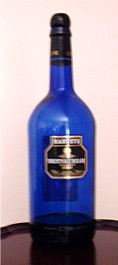
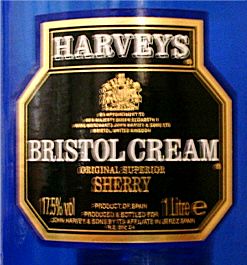 In the eighteenth century, Bristol flourished as a wine port, so it seems is
fitting to associate it with 'Bristol' blue spirit and wine decanters and wine
glasses. It is the home of 'Harvey's - established in 1796, the internationally
famous sherry merchants - Harvey's Bristol cream, still a popular sherry amongst
sherries.
In the eighteenth century, Bristol flourished as a wine port, so it seems is
fitting to associate it with 'Bristol' blue spirit and wine decanters and wine
glasses. It is the home of 'Harvey's - established in 1796, the internationally
famous sherry merchants - Harvey's Bristol cream, still a popular sherry amongst
sherries.
To review past newsletters, just follow this link:
Past newsletters.
To subscribe to this free newsletter -
Click here